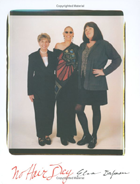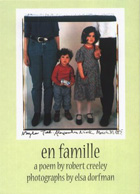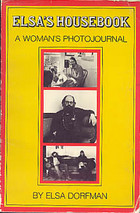Changing New York, Review by Elsa Dorfman
Berenice Abbott. Bonnie Yochelson. The New Press, 1997.$60.00, 399pp.
First off, let it be said that Changing New York, Berenice Abbott’s extended study of the buildings of New York in the latter part of the thirties, edited by Bonnie Yochelson, is a wonderful book. It is a must for anyone interested in photography, in New York City, in urban history and urban magic, in the career of a woman artist. It makes one yearn for a full biography of Abbott (said to be in the works, by Julia van Haaften, Curator of Photographs at New York Public Library).
Abbott has not been ignored, but neither she personally nor her work has ever attracted the attention or the public audiences that attended her more charismatic contemporaries: Walker Evans, Lisette Model, Dorothea Lange. Yeaars ago I remember going to a huge Walker Evans retrospective at the Museum of Modern Art and there, at the same time in a much smaller single gallery, were hanging the portraits of Berenice Abbott. There was no acknowledgement that the bodies of work of the two artists were comparable.
Berenice Abbott is known for four major accomplishments. In 1927 when she was young and living and working in Paris, she singlehandedly saved the entire body of work of Eugene Atget, when he died recognized and appreciated by only a small circle of select artists. Atget, who took photographs of the streets and buildings and parks of Paris, is one ofthe most important photographers in the history of the medium. At the time of his death he was known for taking photographs to help artists with their paintings. For decades Abbott took care of the Atget archive, until in 1968 she was able to sell it to the Museum of Modern Art. In turn,the curators at MOMA mounted several important exhibits and published landmark catalogues of the Atget collection. Her second accomplishment is her work in portraiture. Many of these images are considered the finest portraits taken of their subjects. Her third accomplishment is the series of elegant, instructive images of physics phenomena that she took in the sixties while living in Boston and working with scientists at MIT. And of course, her fourth accomplishment is her city studies, the subject of this book. Each one of these bodies of work is a notable contribution to photography.
Abbott’s important oevre is divided into three parts: her portraits of literary and artistic personalities in Europe and America, her photographs of the buildings of New York, and her photographs of scientific phenomenon, made in collaboration with a group of scientists at M.I.T. in the sixties. In each area, her work is of high distinction. Each body of work is separate and unique. It is unusual that a photographer can be so talented with such different subject matter. In my opinion, Abbott’s talent was enriched by her long relationship with the equally gifted writer and art critic Elizabeth McCausland.
Changing New York is the title of Abbott’s definitive photographic study which she did from 1935 to 1939 with support fromthe Works Progress Administration’s Federal Art Project. This book, with the same title, includes all the images Abbott included in her final cut and exhibitions. The entire group was actually exhibited in …….
Arranged geographiclly into eight sections,the book Changing New York includes 307 duotone plates and 113 variant images, line drawings, and period maps. The divisions: Wall St. Lower East Side, Lower West Side, Greenwich Village, Middle West Side, Middle East Side, North of 59th St. and Outer Boroughs are an obvious organizing principle and one that Abbott followed when taking the pictures. The maps at the front of each section, with each building and place of the image notated, are indispensable. Yochelson has written a clear introduction placing this body of work in context. At the back of the book, she has written a necessary text about Abbott’s choice of images, the fate of the buildings, and the history of New York in that period. She has also included small reproductions of related images, e.g. another view of a particular building. The book is very well executed. The only improvements that come to mind are even more of Yochelson’s arcana on the sites and more biographical material on Abbott.
I have always felt that architectural photography was one of the more intellectual pursuits undertaken with a camera. ( On the other hand, portraiture has always seemed instinctive and intuitive. ) There are a million places to stand and plant your camera, there are hours to wait for the perfect light on the building. There are endless angles to consider when aiming the lense. Endless possibilities of what to include, what to suggest by showing the barest detail. The good news is that the buildings don’t blink or move at the last minute. However, the offending car (and now FEDEX truck) may be parked for a couple of hours in front of the historic portal of the building. Abbott’s achievement is that this collection has one perfect image after another.
Many have said that Berenice Abbott learned well from the work of Atget.( The same has been said of Walker Evans, who often denied he had even seen Atget’s work when he lived in Paris. ) Abbott also worked in 1934 for a few months with the architectural historian Henry Russell Hitchcock. Her images capture the excuberance of America, even though they were taken right in the middle of the Depression. See plate 11, The Flatiron Building flanked by a building whose entire side is painted with an advertisement “Cover the earth.for Beauty and Protection Sherwin-Williams Paints.” Or plate 30, Whelan’s Drug Store, Eighth Avenue and West 44th St. crammed with fountain syringes, sunlamps, valentines, and electric toasters.
One of the distinguishing features of Abbott’s imagery is the signage on the buildings she picked to photograph. No standardized lettering, no corporate look, none of the uniformity we take for granted today. The window of August Pingpank’s barber shop,plate 19, at 413 Bleeker St. in Greenwich Village has a still life in the window. a sign advertizing that razors can be ground, and a mysterious sign for perhaps Mary C. Hessic. The same image includes Abbott’s preference for grounding details at the edges of the frame, in this case a barber pole. Another storefront is emblazoned with the names of J. F. Mirabella Avvocati italiani and Ben J. Levy. Jacob Katz. Below them at 165 East 121 St. is the law offices of Flam and Flam (plate 14) Plate 24 in the Outer Boroughs section shows Fourth Avenue in Brooklyn with a long fence full of posters advertising Ramona at the Albee and William Powell and Carole Lombard in My man Godfrey. Abbott includes two versions of William Goldberg’s emporiam at 771 Broadway at East 9th St., both emblazoned with signs touting two for one sales and felt hats, one simply a few feet closer to the buildings frontage. (plates 40 and 41)..
In the same way that New York was made for the work of Diane Arbus, one could say that New York in the thirties was made for Berenice Abbott. She couldn’t resist Flatbush Avenue betwen State Street and Ashland Place, plate 23, with its incredible wall to wall signs hawking loans, gowns and veils, garcia grande cigars, 25 cent haircuts, and storage vaults. She didn’t walk by Frank Lava’s gunsmith shop at 6 Centre Market Place (plate 29). She didn’t always keep her camera on the sidewalk. She knew when to lug it up the stairs of a nearby building with the perfect vantage point. Plate 24, Tempo of the City, Fifth Avenue and 44th St. hows a crowd of mostly women on the sidewalk rushing, a big one story clock in the foreground dividing the image and anchoring it at the same time. She took the picture of Columbus Circle from the ninth floor of the General Motors Building on West 58th St. Taken through the back of a Schenley Rye neon sign mounted on the seven story New York Journal Building, the image gives the sense of looking through a magical screen . Abbott likes that play between foreground and main part of the image (plate 35).
Abbott also liked to look UP and many of her images are of the new office buildings which were turning up where brownstones had stood. See plate 25, Rockefeller Center with Collegiate Church of St. Nicholas, Fifth Avenue and West 48th Street. Plate 26, Fortieth Street between Sixth and Seventh Avenues shows the contrasting scales of the old buildings and the new in a terrifying way. No funky signage will be decorating those behomeths. She also looked up at the many new bridges crisscrossing the Manhattan skyline and appreciated their sculptural qualities. Many stylistic devices that Abbott used, perhaps learned from Atget, have become part of the photographic vernacular. Notably, her use of trees, lamposts, to divide the frame and add interest. In plate 39, Wanamaker’s at Fourth Avenue and East 9th Street, the lampost for East Ninth is smack in the middle of the image. Her juxtaposition of the old and the new. as in plate 1, 38 Greenwich Street, where laundry from a tenement huddles up against a hulking new building. Anchoring a detail at the edge or in the near foreground, forcing the viewer to look deeper into the image is another technique Abbott used to organize her images. No doubt about it, if Abbott were working now, she would favor Flash PIX cds, where the viewer can zone in and magnify the smallest detail. She would revel in knowing her viewer could find that window with its uneven shade or the smallest sign advertising fresh raisins.
It should be noted that though Abbott had a feel for the street and its contradictions, its visual jive, she also knew how to make a serene and elegant image, almost Hopperesque in its emptiness. See plate 7. Ferries, Foot of West 23rd St. Only a deep shadow and a lone wagon own the empty plaza of the Hoboken Ferry, short route to Newark, North Jersey, and sea shore points. Her man at the automat at 977 Eighth Avenue (plate 34), alone, no one else in the line, seems isolated, yet breaking up the perfect symmetry of the pie section.
Abbott’s intelligent body of work is well served by this book. One is made aware of her unfailing sense of composition and subject matter. All accomplished without grandstanding or the cheap shot. At the same time, mention should be made that on the world wide web there are numerous of Abbott’s images at the site for the New York Public Library and the site for the Museum of the City of New York, the publishers of this book.





